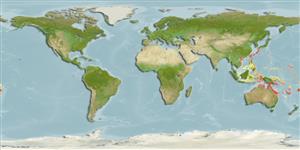Common names from other countries
>
Anguilliformes (Eels and morays) >
Muraenidae (Moray eels) > Uropterygiinae
Etymology: Cirrimaxilla: Latin, cirrus = fringe, curl + Latin, maxilla = jaw.
Environment: milieu / climate zone / depth range / distribution range
Écologie
marin démersal; profondeur 0 - 5 m (Ref. 86942). Subtropical
Northwest Pacific: known only from Nan-wan, Ping-tung County, Taiwan (Ref. 10992). Reported in New Caledonia, found in the stomach of the sea snake Laticauda (Ref. 77055).
Taille / Poids / Âge
Maturity: Lm ? range ? - ? cm
Max length : 16.6 cm TL (female)
Description synthétique
Clés d'identification | Morphologie | Morphométrie
Vertèbres: 132. Body very stout, muscular, elliptical anteriorly, somewhat compressed posteriorly. Dorsal and anal fins restricted to tail end, confluent with caudal fin. Mouth large, lower protruding and slightly curved upward, snout pointed. Jaws with beard-like cirri.
Holotype collected from a tidal pool.
Life cycle and mating behavior
Maturities | Reproduction | Spawnings | Egg(s) | Fecundities | Larves
Chen, H.-M. and K.-T. Shao, 1995. New eel genus, Cirrimaxilla, and description of the type species, Cirrimaxilla formosa (Pisces: Muraenidae) from southern Taiwan. Bull. Mar. Sci. 57(2):328-332. (Ref. 10992)
Statut dans la liste rouge de l'IUCN (Ref. 130435)
CITES (Ref. 128078)
Not Evaluated
Menace pour l'homme
Harmless
Utilisations par l'homme
Outils
Articles particuliers
Télécharger en XML
Sources Internet
Estimates based on models
Preferred temperature (Ref.
115969): 24.5 - 27.9, mean 26.5 (based on 469 cells).
Phylogenetic diversity index (Ref.
82804): PD
50 = 1.0000 [Uniqueness, from 0.5 = low to 2.0 = high].
Bayesian length-weight: a=0.00069 (0.00033 - 0.00144), b=3.12 (2.93 - 3.31), in cm Total Length, based on LWR estimates for this (Sub)family-body shape (Ref.
93245).
Niveau trophique (Ref.
69278): 3.4 ±0.5 se; based on size and trophs of closest relatives
Résilience (Ref.
120179): Haut, temps minimum de doublement de population inférieur à 15 mois (Preliminary K or Fecundity.).
Fishing Vulnerability (Ref.
59153): Low vulnerability (10 of 100).
